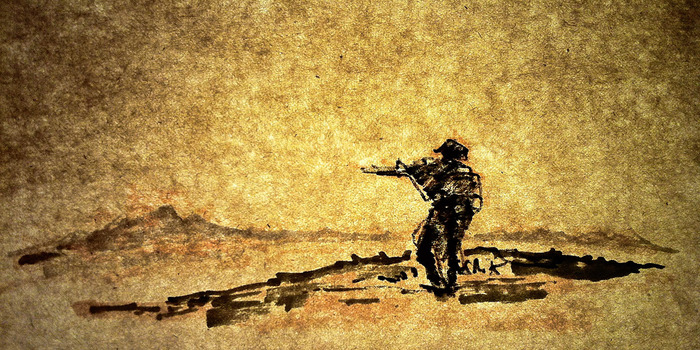 Back to selection
Back to selection
From Kickstarter to PBS: ornana on Confusion Through Sand
 Confusion Through Sand
Confusion Through Sand Nearly a year after its SXSW premiere, ornana’s Confusion Through Sand will have its PBS premiere tonight, ahead of Dan Krauss’ The Kill Team. The animated short will be available for free on Vimeo tomorrow, but for the time being, you can watch a behind the scenes video of the collective’s creative process. Filmmaker spoke to director Danny Madden and producers Jim Cummings and Ben Wiessner about the trajectory of their latest film, from a joint Kickstarter campaign, through division of labor, and securing distribution.
Filmmaker: You packaged your Kickstarter campaign as a sort of two for one deal, raising post funds for euphonia and production funds for Confusion Through Sand. To me, this successfully draws on the notion of ‘fanbase cultivation’ more than the concept of supporting a singular film. What was your rationale behind the campaign?
Ben Wiessner: That was spring 2012 and ornana had only released (notes on) biology — that was the only one people had seen. We were hoping that using both films for the Kickstarter campaign would help our audience understand where we were going and let them know that they were getting in on the ground floor. The original idea was to kickstart ornana as an organization, but that’s against the guidelines. Leveraging both films was as close as we could get. And having both in the pipeline probably helped convince people that we were a little more established than we were at the time. Actually, in the middle of that endless 60 day campaign was when Filmmaker named us to the 2012 New Faces list. We couldn’t have made the Kickstarter without that and the unreal generosity of so many wonderful folks.
Filmmaker: How did you all conceptualize the film? The enactments portrayed in the BTS video prove extreme attention to detail, but what sort of research went into it?
Danny Madden: It probably started years ago, hearing war stories of kids I went to high school with, others from neighbors who fought in Vietnam. Real, personal stories that are usually a mix of violent and funny and terrifying. Then with this project in mind, we reached out and spoke with more people who were/are involved in these kinds of situations. Turns out there are a lot of stranger and more confusing things happening over there than we know about, many were too far out or frightening to play in a short like this.
Filmmaker: Can you speak to the different sets of challenges that arise when producing animation versus live action? You have significantly more time to execute the former, but the margin for mistakes is very slim.
Madden: A challenge of shooting live action is in getting all the elements together — location, equipment, people, time — but then you can experiment some and figure out what works best with all these things in front of you. When animating, the challenge for me is pre-establishing exactly what will be right for a moment before spending all that time trying to draw it frame by frame. The playing and experimenting happens mostly in your mind, then you make strong decisions.
Filmmaker: What is the division of labor amongst ornana when creating an animation? Does Danny do all the drawing? How are the roles divvied up?
Jim Cummings: The work is divided well. Ben and I took over the business and production roles of the company which allowed Danny boy to keep making his drawing deadlines (whenever he wasn’t drawing cartoons of me as a fat guy). Ben and I ran the Kickstarter campaign, doing outreach in a million different ways, privately messaging the 8,000 ‘likers’ of our first animation (notes on) biology, and asking them to donate, emailing the admins of animation groups on Facebook, fielding animation supplies and post-production needs, building an online and festival campaign for euphonia, and just generally producing day to day in our little offices. Ben and I photographed the 8000 frames of animation in Ben’s bedroom and built an extensive festival calendar. Danny did all of the drawing for this movie. We had some wonderful co-animators who came in to do pencil shading and effect work, but in the end, almost every frame in the movie was drawn and cropped by the hands of Danny Madden. And we all kind of have fun making the movies, the “work” is the weeks of creative effort between joking around and throwing water balloons at each other.
Filmmaker: How did the PBS deal come about? Do you have any recommendations for getting shorts distributed on television?
Wiessner: I think persistence is one of the biggest keys to finding broadcasting partners. Persistence and a real lack of guilt when it comes to flooding broadcasters’ inboxes. We started our relationship with PBS last summer when ITVS contacted us about using (notes on) biology for their youtube channel. It was funny, because we had sent that film to various people all over PBS years ago, probably repeatedly, but the right person ended up seeing it at a private screening that a friend was doing for his own Kickstarter (which is the other big lesson, keep showing your shorts!). We really liked working with ITVS, so we made them watch Confusion Through Sand. As it circulated around their office it found the right project to pair with, The Kill Team. We had seen The Kill Team at San Francisco IFF while we were working on Confusion Through Sand, so as soon as the opportunity came together we jumped on it. We called them maybe 5 minutes after they e-mailed us. We are so thankful that this film has the opportunity to reach audiences beyond film festivals and we’re glad to be able to share this story.
